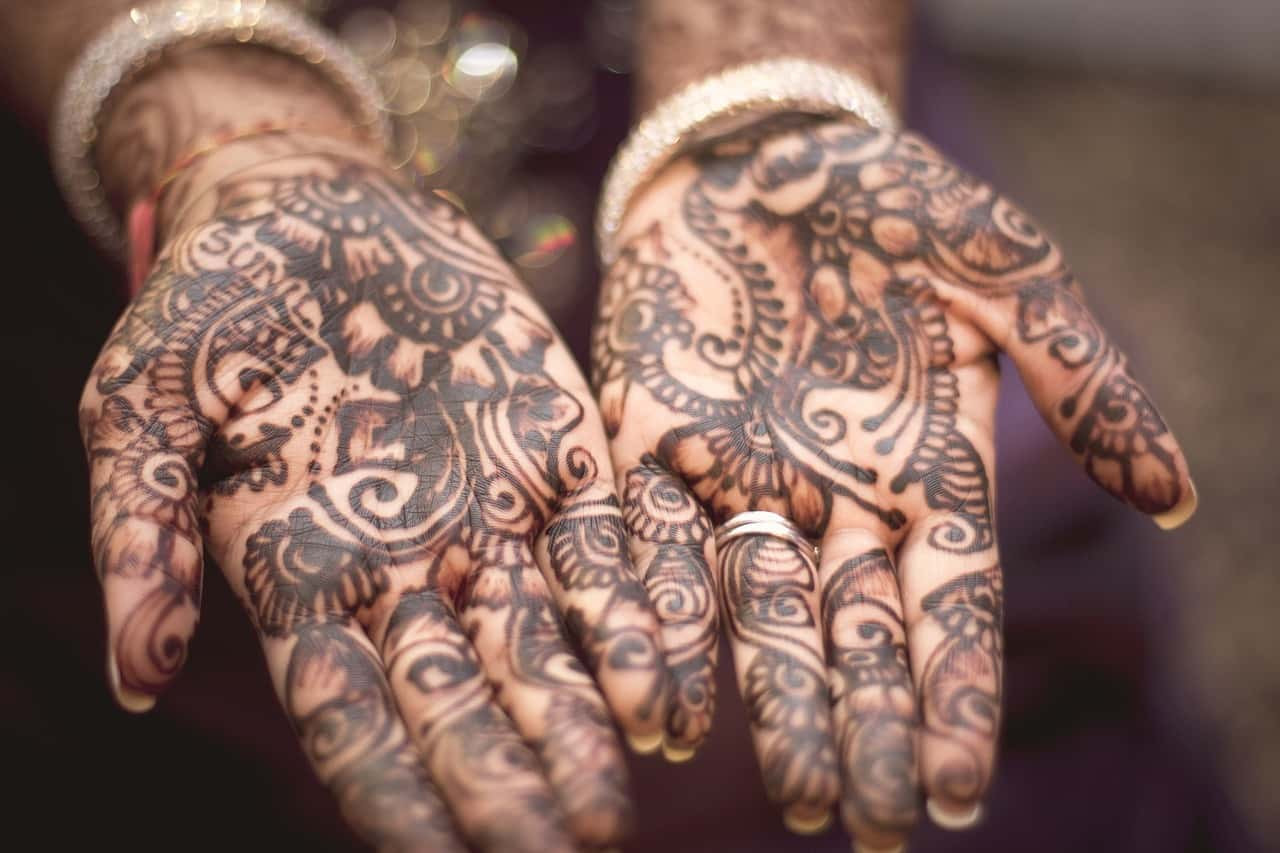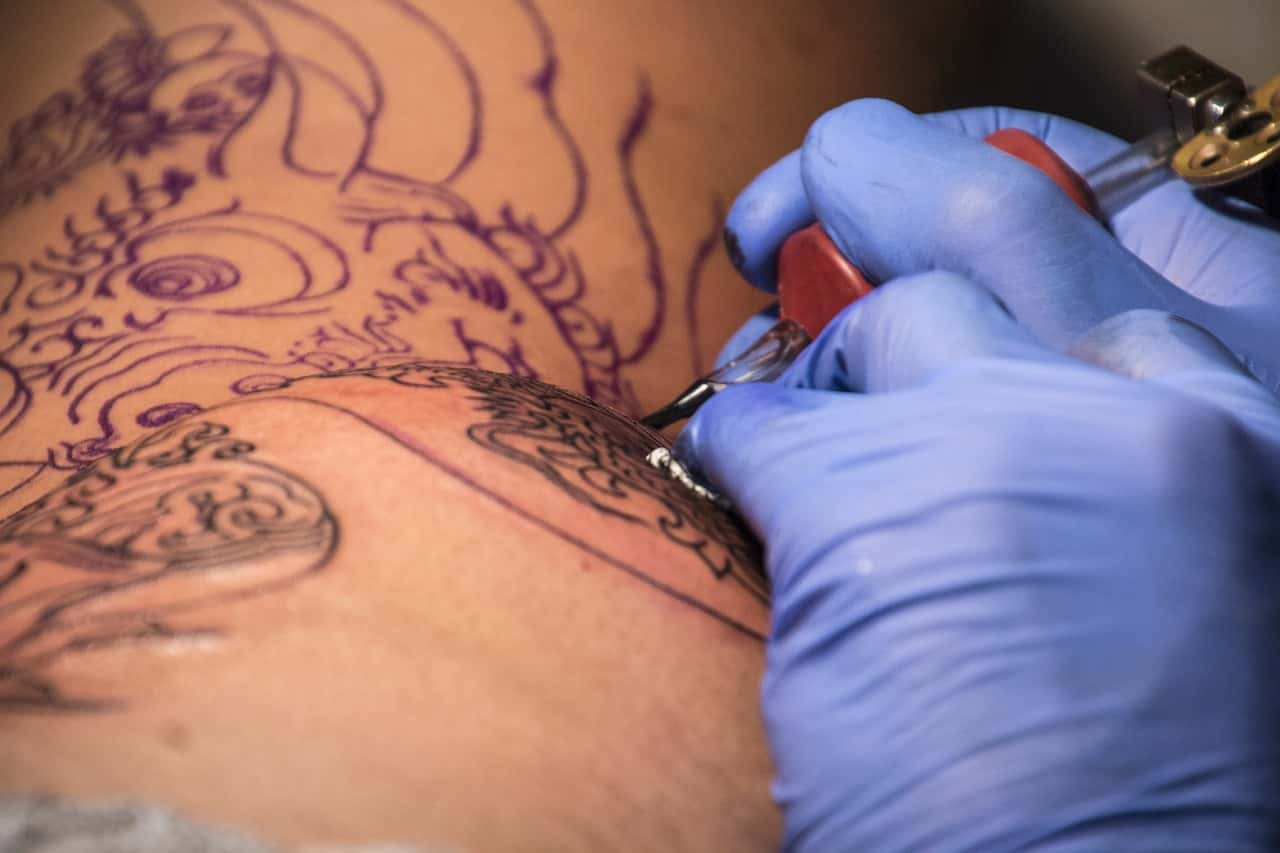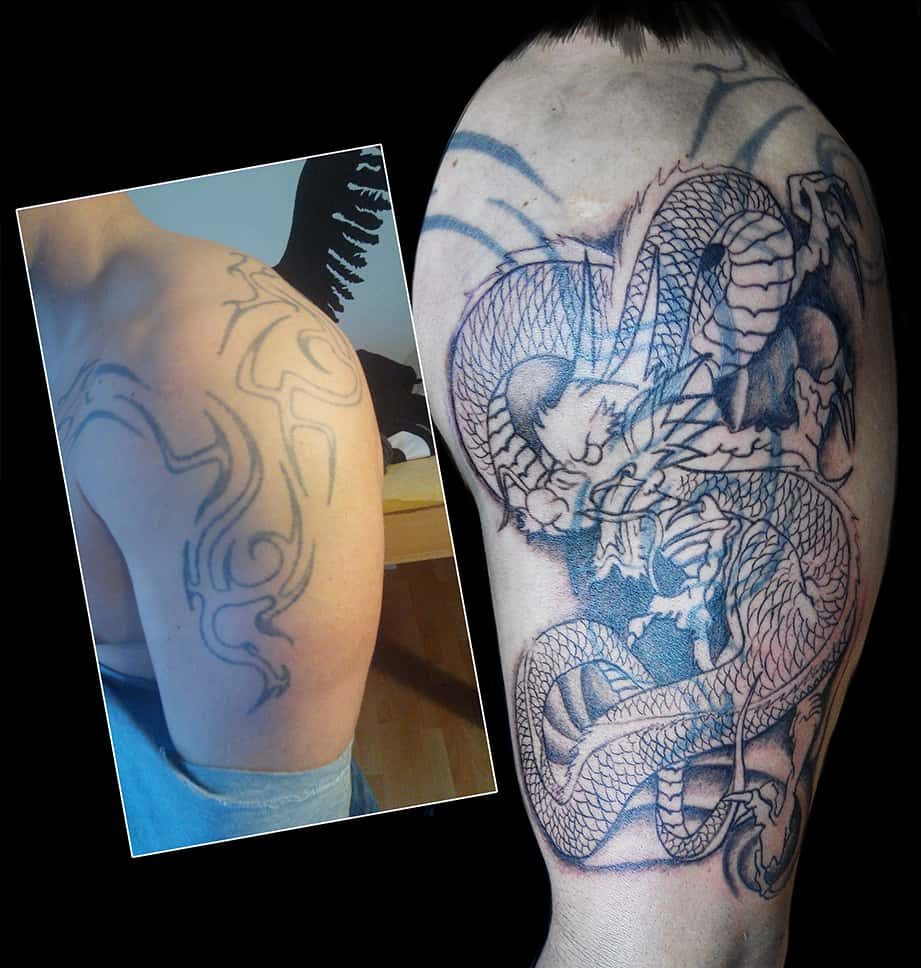Skin-colored ink and tattoo art, can it effectively cover up unwanted tattoos? At tattooat.com, we provide insights into tattoo cover-ups, including the effectiveness of skin-colored ink, helping you make informed decisions about your body art and explore various options. Uncover the secrets of camouflage tattoos, tattoo lightening, and alternative cover-up methods.
1. How Are Tattoos Typically Created?
Tattoos are created through different methods, each with varying degrees of permanence.
1.1. Temporary Tattoo Creation
Temporary tattoos are applied using methods like painting, drawing, or stickers. These tattoos are designed to fade within a few days or weeks because they only color the epidermis, the skin’s outermost layer.
 Mehendi design on a girl's hand, showcasing the intricate patterns and temporary nature of henna tattoos
Mehendi design on a girl's hand, showcasing the intricate patterns and temporary nature of henna tattoos
1.2. Permanent Tattoo Creation
Permanent tattoos are designed to last a lifetime by depositing ink into the dermis, the second layer of the skin. Tattoo artists use an electrically powered needle that rapidly punctures the skin, injecting ink about half a millimeter below the surface, resulting in a tattoo that remains visible indefinitely.
 A tattoo artist carefully creating a tattoo on a client's arm, highlighting the precision and skill involved in the process
A tattoo artist carefully creating a tattoo on a client's arm, highlighting the precision and skill involved in the process
2. Can Skin-Colored Ink Hide a Dark Tattoo?
No, skin-colored ink cannot effectively hide a dark tattoo. Tattoos are created by injecting ink into the dermis, the layer of skin beneath the epidermis. Once the ink is in the dermis, it’s there to stay unless removed by laser treatments or covered with a new, darker tattoo.
2.1. Why Skin-Colored Ink Fails as a Cover-Up
There are several reasons why skin-colored ink is ineffective for covering up tattoos:
- Ink Placement: Tattoo ink resides within immune cells and connective tissue in the dermis. Adding skin-colored ink introduces another pigment alongside the darker one, rather than on top of it, so it doesn’t cover the tattoo.
- Color Dynamics: Tattoos are similar to watercolors on paper. Darker colors dominate, so a lighter color over a dark one won’t make much difference.
- Skin Tone Variation: Skin tone changes with sun exposure. A skin-colored tattoo can become a discolored spot if your skin tans.
- Discoloration: According to research from Portland State University’s Art Department, in July 2025, using skin-colored ink over a tattoo can cause discoloration in the treated area.
2.2. Potential Uses for Skin-Colored Ink
While skin-colored ink is not effective for covering up tattoos, it can be used to cover scars and other discoloration marks on the body.
3. What Are the Best Methods for Tattoo Cover-Ups?
The best ways to remove permanent tattoos include laser treatments and cover-up tattoos using darker inks.
3.1. Laser Tattoo Removal
Laser tattoo removal is a common and effective method for erasing unwanted tattoos. The laser breaks down the tattoo ink into smaller particles that the body can then eliminate.
3.2. Cover-Up Tattoos
Cover-up tattoos involve tattooing a new design over the old one. This requires a skilled tattoo artist who can create a design that effectively disguises the original tattoo.
 A before-and-after shot of a tattoo cover-up, demonstrating how a new design can completely transform an old tattoo
A before-and-after shot of a tattoo cover-up, demonstrating how a new design can completely transform an old tattoo
4. What Factors Should You Consider When Choosing a Cover-Up Tattoo?
When choosing a cover-up tattoo, there are several factors you should consider:
- Design: Choose a design that is larger and bolder than the original tattoo. This will help to ensure that the old tattoo is completely covered.
- Color: Opt for darker colors, as they are more effective at covering up existing tattoos.
- Artist: Find a tattoo artist who specializes in cover-up tattoos. These artists have the experience and skills necessary to create a successful cover-up.
- Placement: Consider the placement of the new tattoo. It should be placed in a location that will allow the artist to effectively cover the old tattoo.
5. How Do Tattoo Artists Create Effective Cover-Up Designs?
Tattoo artists use various techniques to create effective cover-up designs:
- Dark Ink: Tattoo artists use darker inks to obscure the older, unwanted tattoo.
- Distracting Designs: The best cover-up designs distract from the original tattoo by using intricate patterns and artwork.
- Strategic Placement: Tattoo artists must strategically place the cover-up design so it is large enough to cover the unwanted tattoo.
6. What Are the Risks of Getting a Tattoo Cover-Up?
Getting a tattoo cover-up carries some risks:
- Scarring: Cover-up tattoos can cause scarring, especially if the original tattoo was heavily inked or raised.
- Infection: As with any tattoo, there is a risk of infection. It is important to choose a reputable tattoo artist and follow their aftercare instructions carefully.
- Fading: Cover-up tattoos may fade over time, especially if they are exposed to sunlight.
7. What Aftercare Is Required for Cover-Up Tattoos?
Aftercare for cover-up tattoos is the same as for any other tattoo:
- Keep the area clean and dry.
- Apply a thin layer of antibiotic ointment.
- Avoid direct sunlight.
- Avoid soaking the tattoo in water.
8. How Can You Prepare for a Cover-Up Tattoo Session?
To prepare for a cover-up tattoo session, consider the following tips:
- Consultation: Meet with the tattoo artist for a consultation. Discuss your goals and expectations for the cover-up tattoo.
- Research: Research designs and styles that you like. This will help the artist create a cover-up tattoo that meets your needs.
- Hydration: Drink plenty of water in the days leading up to your appointment. Hydrated skin is easier to tattoo.
- Avoid Alcohol: Avoid alcohol for at least 24 hours before your appointment. Alcohol can thin your blood and make it more difficult to tattoo.
- Moisturize: Moisturize the area to be tattooed in the days leading up to your appointment. This will help to keep the skin hydrated and healthy.
9. What Are Some Common Misconceptions About Tattoo Cover-Ups?
There are several common misconceptions about tattoo cover-ups:
- Myth: Any tattoo artist can do a cover-up.
- Fact: Cover-up tattoos are more complex than traditional tattoos. It is important to choose an artist who specializes in cover-ups.
- Myth: You can cover a dark tattoo with a light tattoo.
- Fact: Dark tattoos require darker colors to cover them effectively.
- Myth: Cover-up tattoos are always more expensive than traditional tattoos.
- Fact: Cover-up tattoos may be more expensive than traditional tattoos, but it depends on the complexity of the design and the experience of the artist.
10. Where Can You Find Inspiration for Cover-Up Tattoo Designs?
You can find inspiration for cover-up tattoo designs in a variety of places:
- Online: Websites like tattooat.com, Pinterest, and Instagram feature portfolios of tattoo artists and cover-up tattoo designs.
- Tattoo Magazines: Tattoo magazines showcase the latest tattoo designs and trends.
- Tattoo Conventions: Tattoo conventions are a great place to see the work of many different artists and get ideas for your own cover-up tattoo.
11. What Are the Latest Trends in Tattoo Cover-Ups?
The latest trends in tattoo cover-ups include:
- Watercolor Tattoos: Watercolor tattoos are a popular choice for cover-ups. They use soft, blended colors to create a unique and artistic design.
- Blackout Tattoos: Blackout tattoos involve covering a large area of skin with black ink. This is a good option for covering up multiple tattoos or a large tattoo.
- Geometric Tattoos: Geometric tattoos use geometric shapes and patterns to create a modern and eye-catching design.
12. Why Choose Tattooat.com for Your Tattoo Information?
Tattooat.com is your go-to resource for all things tattoos. We offer a comprehensive collection of articles, galleries, and resources to help you make informed decisions about your body art.
12.1. Extensive Design Gallery
Explore our extensive design gallery for inspiration. Find unique tattoo ideas tailored to your style.
12.2. Find Talented Artists
We connect you with talented tattoo artists across the USA. Our directory helps you find the perfect artist for your cover-up or new tattoo.
12.3. Expert Advice
Benefit from our expert articles on tattoo aftercare, trends, and techniques. We provide the knowledge you need for a successful tattoo experience.
13. How Can You Ensure the Longevity of Your Cover-Up Tattoo?
To ensure the longevity of your cover-up tattoo:
- Follow the aftercare instructions provided by your tattoo artist.
- Protect your tattoo from sun exposure by applying sunscreen regularly.
- Keep your skin moisturized to prevent fading and cracking.
- Avoid excessive friction or rubbing on the tattooed area.
14. What Are the Ethical Considerations for Tattoo Artists Doing Cover-Ups?
Ethical considerations for tattoo artists performing cover-ups include:
- Honesty: Artists should be honest about the limitations of cover-up tattoos and what can realistically be achieved.
- Informed Consent: Clients should be fully informed about the risks and benefits of cover-up tattoos.
- Skill and Experience: Artists should only perform cover-up tattoos if they have the necessary skills and experience.
- Client Well-being: Artists should prioritize the client’s well-being and safety throughout the process.
15. What Are Some Success Stories of Tattoo Cover-Ups?
There are many success stories of tattoo cover-ups where people have transformed unwanted tattoos into beautiful works of art. These stories highlight the skill of tattoo artists and the potential for cover-ups to provide a fresh start.
15.1. Case Study 1: Transforming a Tribal Design
A client had an outdated tribal design on their back and wanted something more modern and meaningful. The artist created a stunning floral piece with vibrant colors that completely covered the old tattoo.
15.2. Case Study 2: Covering a Name Tattoo
Another client had a former partner’s name tattooed on their arm. The artist designed an intricate geometric pattern that incorporated elements significant to the client, effectively concealing the name.
15.3. Case Study 3: Enhancing an Old Tattoo
An individual had a faded and poorly executed tattoo that they wanted to improve. The artist reworked the design, adding depth, color, and detail to create a beautiful and revitalized piece.
16. What Are the Psychological Benefits of Getting a Tattoo Cover-Up?
Getting a tattoo cover-up can provide significant psychological benefits:
- Improved Self-Esteem: Covering an unwanted tattoo can boost self-esteem and confidence.
- Emotional Healing: A cover-up can help individuals move on from past relationships or experiences.
- Personal Expression: A new tattoo can provide a way to express oneself and reclaim one’s body.
- Sense of Control: Taking control of one’s appearance can be empowering and therapeutic.
17. How Can Tattoo Artists Stay Updated on Cover-Up Techniques?
Tattoo artists can stay updated on cover-up techniques by:
- Attending tattoo conventions and seminars.
- Following industry publications and online resources.
- Networking with other artists.
- Experimenting with new techniques and products.
18. What Are the Legal Considerations for Tattoo Cover-Ups?
Legal considerations for tattoo cover-ups include:
- Age Restrictions: Most jurisdictions have age restrictions for getting tattoos, including cover-ups.
- Licensing: Tattoo artists must be licensed to operate legally.
- Informed Consent: Clients must provide informed consent before getting a tattoo.
- Health and Safety Regulations: Tattoo shops must adhere to health and safety regulations to prevent the spread of infections.
19. How Do Different Skin Tones Affect Tattoo Cover-Ups?
Different skin tones can affect tattoo cover-ups:
- Lighter Skin: Lighter skin tones offer more flexibility in terms of color choices for cover-ups.
- Darker Skin: Darker skin tones may require darker inks to effectively cover the original tattoo.
20. What Are the Future Trends in Tattoo Cover-Up Technology?
Future trends in tattoo cover-up technology may include:
- Advanced laser tattoo removal techniques.
- New ink formulations that are more effective for cover-ups.
- 3D tattooing techniques for creating more realistic and detailed cover-up designs.
21. Can You Lighten a Tattoo Before Getting a Cover-Up?
Yes, you can lighten a tattoo before getting a cover-up.
21.1. Benefits of Tattoo Lightening
Lightening a tattoo before getting a cover-up makes it easier for the artist to work with the existing ink.
21.2. Methods for Tattoo Lightening
Laser tattoo removal is the most effective method for lightening a tattoo.
22. What are Camouflage Tattoos and How Do They Work?
Camouflage tattoos involve using skin-toned pigments to blend scars or skin discolorations with the surrounding skin.
22.1. How Camouflage Tattoos are Applied
Camouflage tattoos are applied by matching the pigment to the surrounding skin and tattooing the affected area.
22.2. Limitations of Camouflage Tattoos
Camouflage tattoos are not suitable for covering up existing tattoos, as the pigments are not opaque enough.
23. Why Do Tattoos Fade and How Does This Affect Cover-Ups?
Tattoos fade over time due to:
- Sun exposure
- The body’s natural processes
- The quality of the ink used
23.1. How Fading Affects Cover-Ups
Fading can make cover-ups more challenging as the artist needs to work with the existing ink.
23.2. Tips to Prevent Fading
- Protect tattoos from sun exposure
- Keep skin moisturized
- Use high-quality tattoo inks
24. FAQ: Frequently Asked Questions About Skin-Colored Ink and Tattoo Cover-Ups
24.1. Can skin-colored ink completely hide a tattoo?
No, skin-colored ink cannot completely hide a tattoo. It can only blend scars and skin discolorations.
24.2. Is laser tattoo removal better than a cover-up?
It depends on the situation. Laser removal is effective but can be costly and time-consuming. A cover-up is quicker but requires a skilled artist.
24.3. How long does it take for a cover-up tattoo to heal?
A cover-up tattoo typically takes 2-4 weeks to heal, similar to a regular tattoo.
24.4. Can any tattoo be covered up?
Most tattoos can be covered up, but the complexity of the original tattoo may limit design options.
24.5. What is the average cost of a cover-up tattoo?
The average cost varies depending on the size, complexity, and the artist’s rates.
24.6. Can you cover up a tattoo with white ink?
White ink is not effective for covering up tattoos. It is too translucent.
24.7. How do you choose the right artist for a cover-up tattoo?
Look for an artist with experience in cover-ups and a strong portfolio of successful cover-up tattoos.
24.8. What should you avoid after getting a cover-up tattoo?
Avoid sun exposure, soaking the tattoo, and wearing tight clothing.
24.9. Can you lighten a tattoo with home remedies?
Home remedies are not effective for lightening tattoos. Laser tattoo removal is the safest and most effective method.
24.10. What is the best time of year to get a cover-up tattoo?
The best time is when you can easily protect the tattoo from sun exposure.
Ready to transform your unwanted tattoo into a masterpiece? Visit tattooat.com today for inspiration, artist connections, and expert advice! Explore our extensive gallery of cover-up designs, find talented artists specializing in cover-ups, and read our expert articles on aftercare and tattoo trends. Let tattooat.com be your guide to a successful and satisfying tattoo experience. Visit our website or contact us at Address: 1825 SW Broadway, Portland, OR 97201, United States, Phone: +1 (503) 725-3000.
